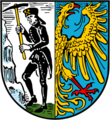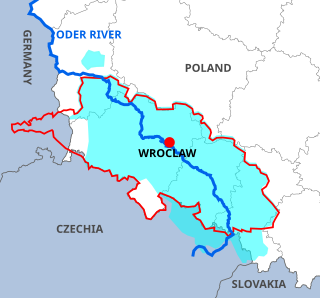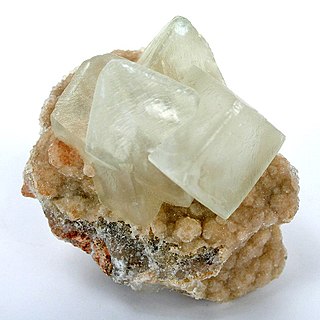
A coat of arms is a heraldic visual design on an escutcheon, surcoat, or tabard. The coat of arms on an escutcheon forms the central element of the full heraldic achievement which in its whole consists of shield, supporters, crest, and motto. A coat of arms is traditionally unique to an individual person, family, state, organization or corporation.
The Piast dynasty was the first historical ruling dynasty of Poland. The first documented Polish monarch was Prince Mieszko I. The Piasts' royal rule in Poland ended in 1370 with the death of king Casimir III the Great.
In heraldry, gules is the tincture with the colour red. It is one of the class of five dark tinctures called "colours", the others being azure (blue), sable (black), vert (green) and purpure (purple).

In heraldry, supporters, sometimes referred to as attendants, are figures or objects usually placed on either side of the shield and depicted holding it up.

The Coat of arms of the Philippines (Spanish: Escudo de Filipinas) features the eight-rayed sun of the Philippines with each ray representing the eight provinces which were placed under martial law by Governor-General Ramón Blanco during the Philippine Revolution, and the three five-pointed stars representing the three primary geographic regions of Luzon, Visayas, and Mindanao.

Złotoryja is a historic town in Lower Silesian Voivodeship in southwestern Poland, the administrative seat of Złotoryja County, and of the smaller Gmina Złotoryja. Having been granted town privileges in 1211, Złotoryja is the oldest town in the whole country. Since the Middle Ages, it was a centre of gold and copper mining. Złotoryja was also featured among the most beautiful towns in Poland due to its location and architectural heritage.

In heraldry, a charge is any emblem or device occupying the field of an escutcheon (shield). This may be a geometric design or a symbolic representation of a person, animal, plant, object or other device. In French blazon, the ordinaries are called pièces while other charges are called meubles.
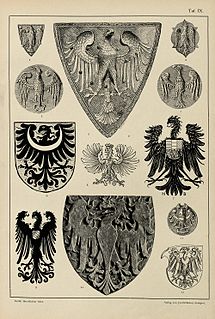
The eagle is used in heraldry as a charge, as a supporter, and as a crest. The symbolism of the heraldic eagle is connected with the Roman Empire on one hand, and with Saint John the Evangelist on the other.
In classical heraldry, vert is the tincture equivalent to the colour "green". It is one of the five dark tinctures (colours). The word vert is simply the French for "green". It is used in English in the sense of a heraldic tincture since the early 16th century. In Modern French, vert is not used as a heraldic term. Instead, the French heraldic term for green tincture is sinople. This has been the case since c. the 16th century. In medieval French heraldry, vert also meant "green" while sinople was a shade of red. Vert is portrayed by the conventions of heraldic "hatching" by lines at a 45-degree angle from upper left to lower right, or indicated by the abbreviation vt. when a coat of arms is tricked.

In heraldry and heraldic vexillology, a blazon is a formal description of a coat of arms, flag or similar emblem, from which the reader can reconstruct the appropriate image. The verb to blazon means to create such a description. The visual depiction of a coat of arms or flag has traditionally had considerable latitude in design, but a verbal blazon specifies the essentially distinctive elements. A coat of arms or flag is therefore primarily defined not by a picture but rather by the wording of its blazon. Blazon also refers to the specialized language in which a blazon is written, and, as a verb, to the act of writing such a description. This language has its own vocabulary, grammar and syntax, which becomes essential for comprehension when blazoning a complex coat of arms.
The biscione, also known as "the vipera", is a heraldic charge showing on argent an azure serpent in the act of consuming a human; usually a child and sometimes described as a Moor or an Ottoman Turk. It was the emblem of the Visconti of Milan from the 11th century, becoming associated with Milan as the Visconti gained control over the city in 1277. When the Visconti family died out in the 15th century, the emblem retained its association with the Duchy of Milan and became part of the coats of arms of the House of Sforza; the presence of biscione in Poland (Sanok) and Belarus (Pruzhany) is due to queen Bona Sforza.
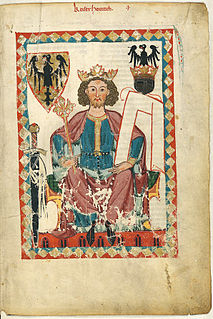
The Reichsadler is the heraldic eagle, derived from the Roman eagle standard, used by the Holy Roman Emperors and in modern coats of arms of Germany, including those of the Second German Empire (1871–1918), the Weimar Republic (1919–1933) and the Third Reich.

The Serbian eagle is a double-headed heraldic eagle, a common symbol in the history of Serbian heraldry and vexillology. The double-headed eagle and the Serbian cross are the main heraldic symbols which represent the national identity of the Serbian people across the centuries. It originated from the medieval Nemanjić dynasty. The eagle, defaced with the cross, has been used in the contemporary design of the coat of arms of Serbia following the tradition established by the Kingdom of Serbia in 1882.
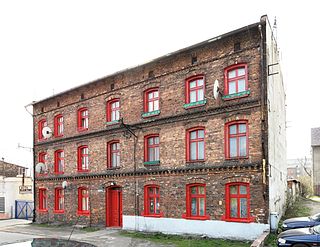
Familok is a type of house for many families, designed for workers of the heavy industry, mainly coal miners, built at the end of the 19th century and beginning of the 20th century in the cities and towns of Poland.

German heraldry is the tradition and style of heraldic achievements in Germany and the Holy Roman Empire, including national and civic arms, noble and burgher arms, ecclesiastical heraldry, heraldic displays and heraldic descriptions. German heraldic style is one of the four major broad traditions within European heraldry and stands in contrast to Gallo-British, Latin and Eastern heraldry, and strongly influenced the styles and customs of heraldry in the Nordic countries, which developed comparatively late. Together, German and Nordic heraldry are often referred to as German-Nordic heraldry.

Dexter and sinister are terms used in heraldry to refer to specific locations in an escutcheon bearing a coat of arms, and to the other elements of an achievement. "Dexter" means to the right from the viewpoint of the bearer of the shield, i.e. the bearer's proper right, to the left from that of the viewer. "Sinister" means to the left from the viewpoint of the bearer, the bearer's proper left, to the right from that of the viewer.
A national coat of arms is a symbol which denotes an independent state in the form of a heraldic achievement. While a national flag is usually used by the population at large and is flown outside and on ships, a national coat of arms is normally considered a symbol of the government or the head of state personally and tends to be used in print, on heraldic china, and as a wall decoration in official buildings. The royal arms of a monarchy, which may be identical to the national arms, are sometimes described as arms of dominion or arms of sovereignty.

